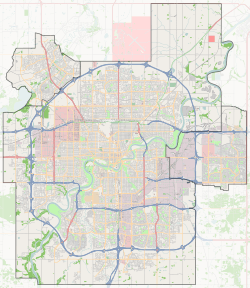Strathcona, Alberta facts for kids
Quick facts for kids
Strathcona
South Edmonton (1891–1899)
|
|
|---|---|
| Country | Canada |
| Province | Alberta |
| City | Edmonton |
| Founded | September 25, 1891 |
| Incorporated | |
| • Town | May 29, 1899 |
| • City | March 15, 1907 |
| Amalgamated | February 1, 1912 |
| Elevation | 673 m (2,208 ft) |
Strathcona was a city in Alberta, Canada. It was located on the south side of the North Saskatchewan River. It started as a railway center in 1891. Later, it became a town in 1899 and then a city in 1907. In 1912, Strathcona joined with the City of Edmonton. This joining is called an amalgamation.
Contents
Strathcona's Journey: From Settlement to City
|
||||||||||||||||||||||||
Early Beginnings and Growth
Strathcona's story began in the 1870s. Its first residents were people who lived near the old Fort Edmonton. This fort was on the north side of the river. This community included British, Québécois, Cree and Metis people. They were fur traders, farmers, and hunters.
In the 1880s, many pioneer farmers from eastern Canada moved to the area. The Papaschase First Nation had been granted about 40 square miles of land here. However, they later moved due to pressure from new settlers. These settlers wanted to develop the land.
The Railway Arrives
The Calgary and Edmonton Railway came to the area in 1891. This led to the founding of "South Edmonton." It was centered on what is now Whyte Avenue. The town's plan was officially recorded on September 25, 1891.
Businesses quickly opened in simple shacks, some made of logs. They served many new immigrants. These people came by train from eastern Canada, Britain, Europe, and the U.S. They thought "South Edmonton" would become bigger than "Old Edmonton" across the river.
From Shacks to Strong Buildings
South Edmonton was in a good spot for businesses near the railway. Over the next 20 years, many of the simple buildings were replaced. They became stronger, two-story buildings made of wood or brick. Many of these older buildings still stand today.
The original Strathcona Hotel and the Ross Block are examples. They were built in the late 1800s and are still here, though they have been made larger.
Becoming a Town and Then a City
On May 29, 1899, South Edmonton officially became the Town of Strathcona. It was named after Lord Strathcona, Donald A. Smith. He was an important person in the Hudson's Bay Company and the Canadian Pacific Railway. The railway was very important to the community.
Thomas Bennett was the first mayor of Strathcona. The town's first boundaries stretched from 109 Street in the west to 97 Street in the east. They went from the river south to University Avenue. This area was about 1,000 acres.
Building for Safety
In 1902, many prairie towns had big fires. To prevent this, Strathcona's town council passed a rule. It said all new buildings must be made of fire-resistant materials, like brick. This rule helped keep many old buildings safe.
Because of this, Whyte Avenue and the area around it have many historic buildings. It is one of the largest collections of old buildings in western Canada.
Home to the University of Alberta
Strathcona became a city on March 15, 1907. The Premier of Alberta, Alexander Cameron Rutherford, helped establish the University of Alberta in Strathcona that same year. They bought 258 acres of land for the campus on the city's west side.
Before the university's main buildings were ready, classes were held in other places. First, they used the Queen Alexandra Public School. Then, they moved to the building that is now Old Scona Academic High School.
Joining with Edmonton
In 1911, Strathcona had 5,579 people. Edmonton had 24,900 people. People thought joining the two cities would bring benefits like lower taxes. Both cities voted to merge.
The joining of Strathcona and Edmonton happened on February 1, 1912. This meant more police services and cheaper public transportation for Strathcona residents. At the time of the merger, Strathcona's borders were the North Saskatchewan River to the west and north. They also included 91 Street to the east and parts of 62 Avenue and 68 Avenue to the south.
Strathcona Today
Today, the neighbourhood of Strathcona is part of Edmonton. It covers the area east of 107 Street, north of Whyte Avenue, west of the Mill Creek ravine, and south of the North Saskatchewan River valley. The historic business area of the former city is now called the Old Strathcona Provincial Historic Area. It is a special place that protects its history.



